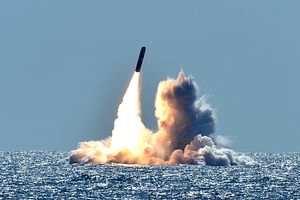The Ohio-class nuclear-powered ballistic missile submarine (SSBN) USS Nebraska, assigned to the U.S. Navy’s Submarine Group 9, test fired two Trident II D5 ballistic missiles from a submerged position in the Pacific Missile Range off the coast of California on March 26, the U.S. Navy said in a statement.
The test firings of the submarine-launched Trident II D5 ballistic missiles (SLBM) were conducted as part of a so-called Demonstration and Shakedown Operation (DASO). “The primary objective of the DASO is to evaluate and demonstrate the readiness of the SSBN’s strategic weapon system and crew before operational deployment following midlife refueling overhaul,” according to the Navy.
“The missiles were launched as a double mission test and were the key element of DASO 28, which marked the 166th and 167th successful test flights of the Trident II D5 missile since its introduction to the fleet in 1989,” the service said. The Navy did not offer additional details regarding the missile tests.
The Trident II D5 is the U.S. Navy’s latest SLBM and first introduced into service in 1989. Trident II D5 a three-stage, solid propellant ballistic missile with a range of about 4,000 nautical miles or around 7,400 kilometers. The missile is fitted with multiple independently targetable reentry vehicles each carrying a thermonuclear warhead. (The Navy is currently in the process of upgrading the Trident missile’s reentry vehicle housing the warhead.)
According to the Bulletin of the Atomic Scientists: “The Trident D5s carry three types of warheads: the 100-kiloton W76/Mk-4, the 100-kiloton W76-1/Mk-4A, and the 455-kiloton W88/Mk-5 warhead, the highest-yield ballistic missile warhead in the U.S. arsenal.” The last test firing of Trident missiles occurred in February 2017. Overall, the missile has been test launched over 160 times.
The Ohio-class of SSBNs are the sea leg of the U.S.’ strategic nuclear deterrent triad and a critical element of the country’s second-strike capability. As I explained last February:
The lead boat of the Ohio-class first entered service in 1981 with the last submarine of the class commissioned in 1997. The U.S. Navy is currently operating 14 Ohio-class SSBNs, capable of carrying up to 24 Trident II D-5 submarine-launched ballistic missiles.
A new class of SSBNs, the Columbia-class, which will begin replacing the Ohio-class in 2031, will be fitted with 16 instead of 24 Trident II D-5 missile launch tubes. The future Columbia-class is designed for a 42-year service life all the way through 2085. It will be the largest U.S. SSBN ever to enter service with the U.S. Navy. The service plans to operate a fleet of 12 Columbia-class SSBNs by the 2040s.

































